Germany’s Mosel River Valley is a magical destination home to medieval small towns, scenic vineyards, and plenty more unique things to do and beautiful places to see.
Nestled in central, western Germany near the Belgium, Luxembourg, and French border, The Mosel River Valley is a region unlike any other. The area is best known for its vast wine producing roots, home to some of the best German Rieslings. Not to mention some of the best preserved Roman ruins in Europe.
Although there aren’t any classic big German cities in the region, it is conveniently about two hours west of Frankfurt and south of Cologne and Dusseldorf. This means the Mosel River is within driving distance from some of Germany’s classic tourist destinations.
If you hope to see a unique part of Germany and get off the beaten path, the Mosel River Valley is an excellent choice. Here’s everything you need to know about visiting and exploring this scenic region.
This post may contain affiliate links, meaning at no additional cost to you, if you click my links and make a purchase, I may earn a small commission. Learn more on my disclosure page. Thank you for your support!
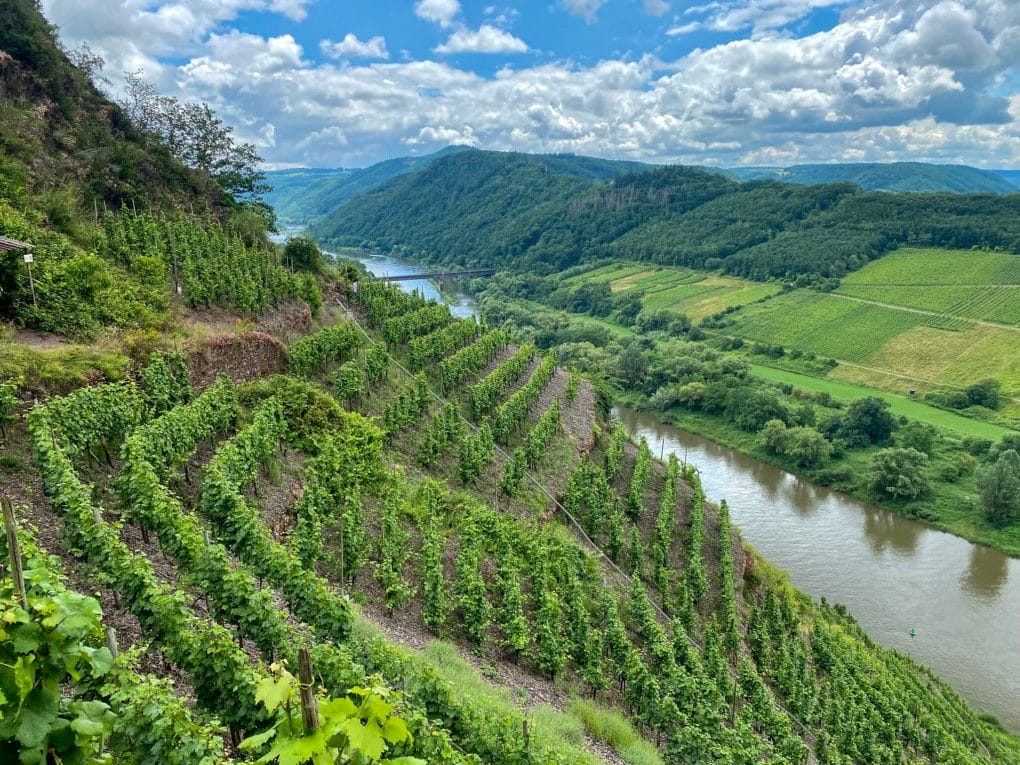
Where is the Mosel River Valley?
Following the Mosel River, the Mosel Valley runs through western Germany, eastern Luxembourg, and northeastern France, meandering through the picturesque landscapes of the Rhineland Pfalz region.
Renowned for its steep vineyards, charming villages, and medieval castles, the Mosel River Valley is a captivating stretch between the Eifel and Hunsrück mountain ranges.
When is the best time to visit the Mosel Valley?
Summer and fall are the best times to visit the Mosel Valley in Germany. The region is known for its gloomy and rainy weather year round, but it’s less so in the summer. Additionally, the vineyards are prettiest when they have leaves on their vines.
Although the weather is cooler, fall brings colorful foliage on trees and grape vines, a beautiful sight to see. In the winter, German Christmas markets go into full swing, which is undeniably a unique thing to experience.
How to See the Mosel Valley
By car is one of the best ways to see the Mosel Valley. It allows you the ultimate freedom to explore even rural areas at your own pace.
By train is another convenient way to see the region for those who wish to avoid dealing with a car rental. However, trains in Germany can be pricey, and the best places to visit here don’t all have train access like Burg Eltz, Bernkastel Kues, and Beilstein, for example.
By water is probably one of the most scenic and exciting ways to explore the Mosel River Valley. There are a variety of Mosel cruise options that range from day trips to week-long getaways and are an experience in and of themselves.
9 Most Beautiful Places to Visit in the Mosel River Valley
These are just the tip of the iceberg, and there are other villages along the Mosel you may want to check out!

1. Trier
Trier is known as Germany’s oldest city thanks to its historical ties to ancient Rome. In fact, some of the best things to do in Trier include seeing well-preserved ruins like the famed Porta Nigra and Roman baths.
This mid-sized city makes for a perfect day trip or jumping off point for a weekend exploring other nearby places like Luxembourg. While in Trier, I recommend having a glass of wine at the stand in the main square and taking advantage of the city’s many great places to eat.
Where to stay in Trier: Hotel Villa Hügel ($$$) and B&B Hotel Trier ($)
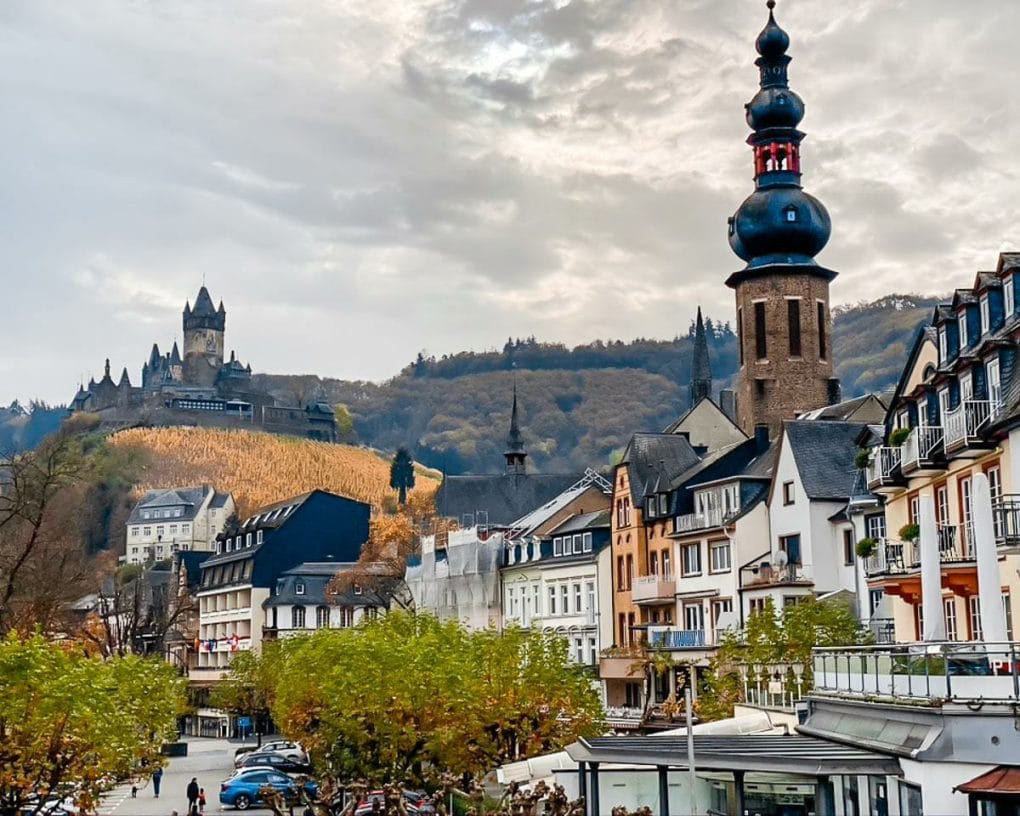
2. Cochem
Cochem is a small town nestled along the banks of the Mosel River, enchanting visitors with its fairytale charm, hilltop medieval castle perched on a hillside, and colorful half-timbered houses.
The river passes alongside the main downtown area, lined with terrace seating. Some unique things to do in Cochem include hiking the Pinnerkruez loop, riding the cable car, and enjoying a Knights Meal at the Reichsburg Castle.
Where to stay in Cochem: Villa Sonnenblick ($$$) and Hotel Traumblick ($$)
3. Koblenz
Koblenz is one of the largest cities in the Mosel Valley and is perched where the Rhine and Mosel rivers meet.
This vibrant city boasts a historic old town, a monumental fortress, and river promenades, providing a perfect blend of cultural exploration and picturesque landscapes. As the region’s largest city, it’s where many of Mosel’s train routes connect and continue.
Where to stay in Koblenz: Fährhaus Hotel ($$$$) and Vintage Meets Modern ($$)
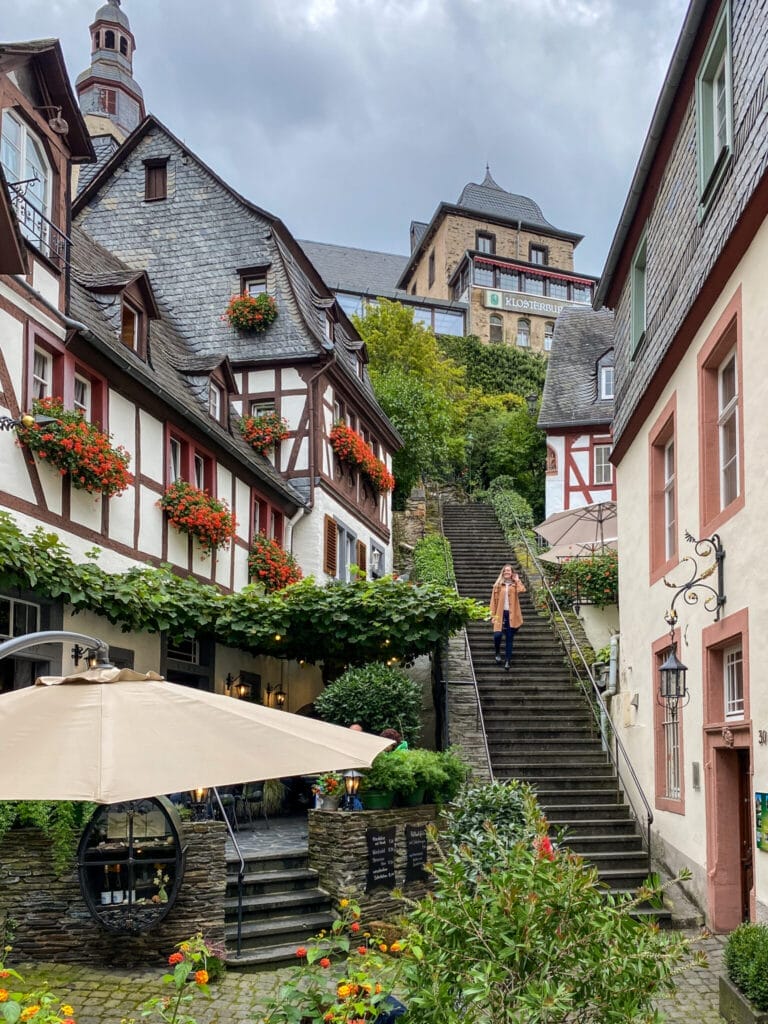
4. Beilstein
Beilstein is a tiny Mosel town that’s big on charm. Its photogenic streets, half timber buildings, and historic wine cellars are worth the effort to get there.
You really only need a day in Beilstein. It’s also a common stop on a Mosel River Valley cruise.
Where to stay in Beilstein: Hotel Lipmann “Am Klosterberg” and Hotel Halfenstube & Villa Spa 1894 and Hotel Haus Burg Metternich

5. Moselschleife in Bremm
As another tiny Mosel town, Bremm’s main draw is its exciting hiking trail where you can climb through Europe’s steepest vineyard. The route is called the Calmont-Klettersteig and begins behind the town’s picturesque church. It is just over four miles long (7km) when completed as a loop.
Along the way, you’ll pass a lookout point over the Moselschleife, an iconic bend in the Mosel. Be sure to bring cash because, during wine season, a stand opens serving glasses and bottles from the Michael Franzen winery.
Bremm is best as a day trip.
6. Traben Trarbach
Traben-Trarbach, nestled in the heart of the Mosel River Valley in Germany, is a charming travel destination celebrated for its well-preserved Art Nouveau architecture and its role as a renowned wine town. Visitors can explore its historic streets, visit underground wine cellars, and enjoy the scenic beauty of the Mosel River, creating a delightful experience for wine enthusiasts and history buffs alike.
Traben Trarbach is also home to a unique Christmas market hosted in an underground wine cellar!
Where to stay in Traben Trarbach: Moselschlösschen Spa & Resort ($$$) and Weingut Caspari, Familie Eggert ($)
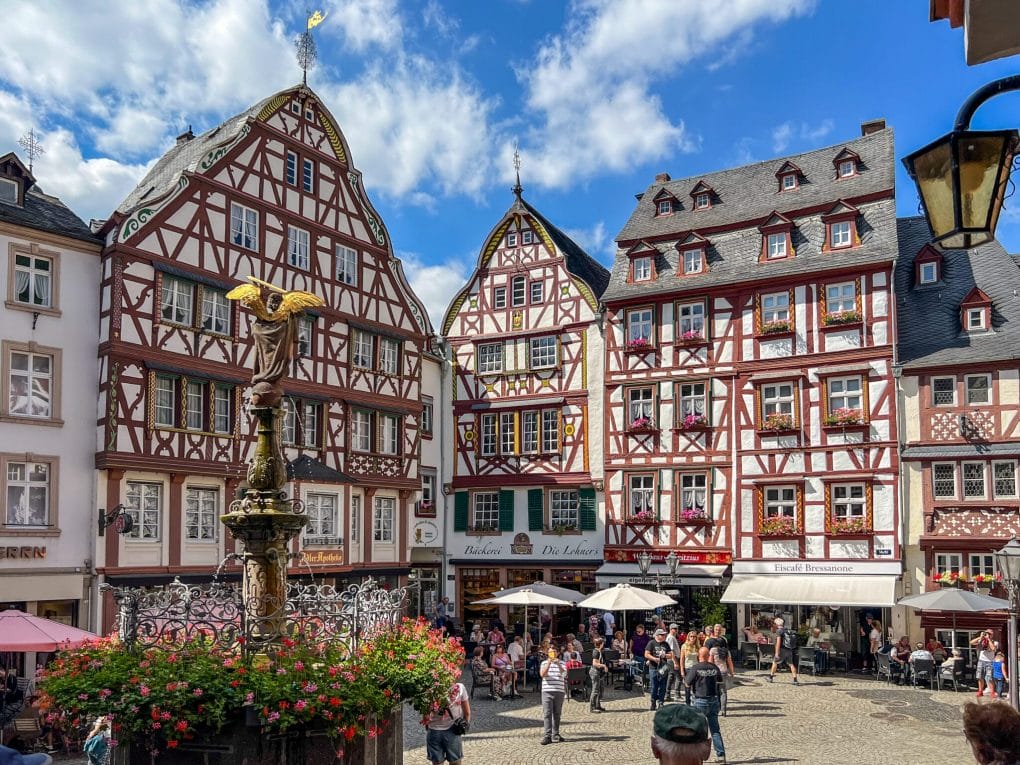
7. Bernkastel Kues
When not soaking up the picturesque details of the center’s timber frame buildings and cobblestone streets, take the time to sip wine and nibble on traditional German fare. Driving or hiking up to the Castle Landshut lookout, where you can book a nice meal at the restaurant nestled within the castle ruins, is also a must.
Other exciting things to do in Bernkastel Kues include booking a wine tasting or a river cruise. If you can, try to time your visit during the city’s annual wine fest in late August or for the Christmas Market home to one of Germany’s largest advent calendars.
Where to stay in Bernkastel Kues: Lifestyle Resort zum Kurfürsten ($$$$), Deinhard’s ($$) and Hotel Doctor Weinstube ($$)

8. Burg Eltz
Burg Eltz is one of Germany’s most beautiful places, and I highly recommend it to anyone in the Mosel Region. This medieval castle has stood the test of time, and has been owned and lived in by the same family since the 12th century.
The castle is open for tours seasonally, and features a scenic hiking route that encircles the castle grounds and offers excellent views. It’s not easy to reach via public transportation and is best to drive, although there is a bus you can take from Koblenz.
Burg Eltz is best as a day trip.
9. Zell
Famous for its Zeller Schwarze Katz wine, Zell is a charming town with a lively market square. This small town features all the hallmarks of a Mosel Valley small town, including scenic vineyards, quaint wine bars (weingut), and half-timber homes.
The area is also known for scenic hiking trails. However, the town is only about 4,000 people and quite small, making it best for a day trip.
16 Unique Things to Do In and Around the Mosel Valley
If you’re not satisfied with the incredible beautiful destinations above, here are even more unique things to do in the Mosel River Valley!
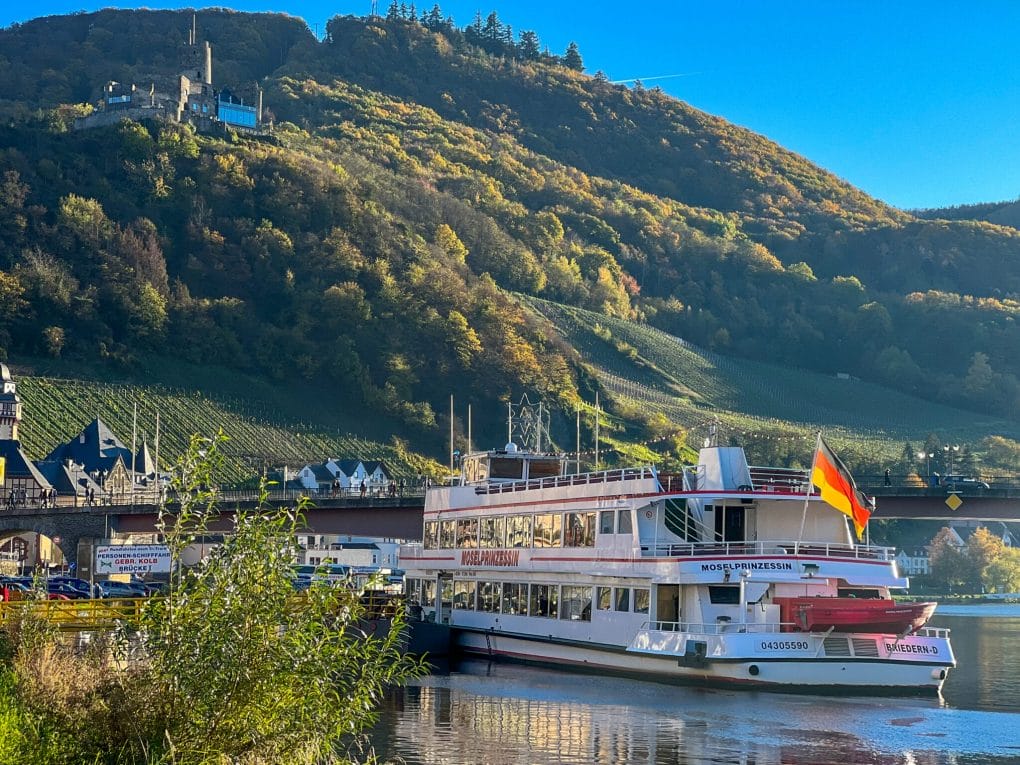
1. Enjoy a peaceful way to see the scenic beauty on a Mosel River cruise
As previously mentioned, one of the best ways to get around and explore the Mosel River Valley is on a river cruise! It’s an exciting activity and a way to see these charming towns from a new vantage point. Many cruises even serve wine as you sail.

2. Visit a winery and sample local Riselings and wines
Wine lovers are certainly spoiled for choice when it comes to wine bars, tours, and tastings throughout the Mosel Valley. Prepare to sample endless pours of classic German Riesling wine, roses, and occasional red.
You can read up on some of the best Mosel wineries here.
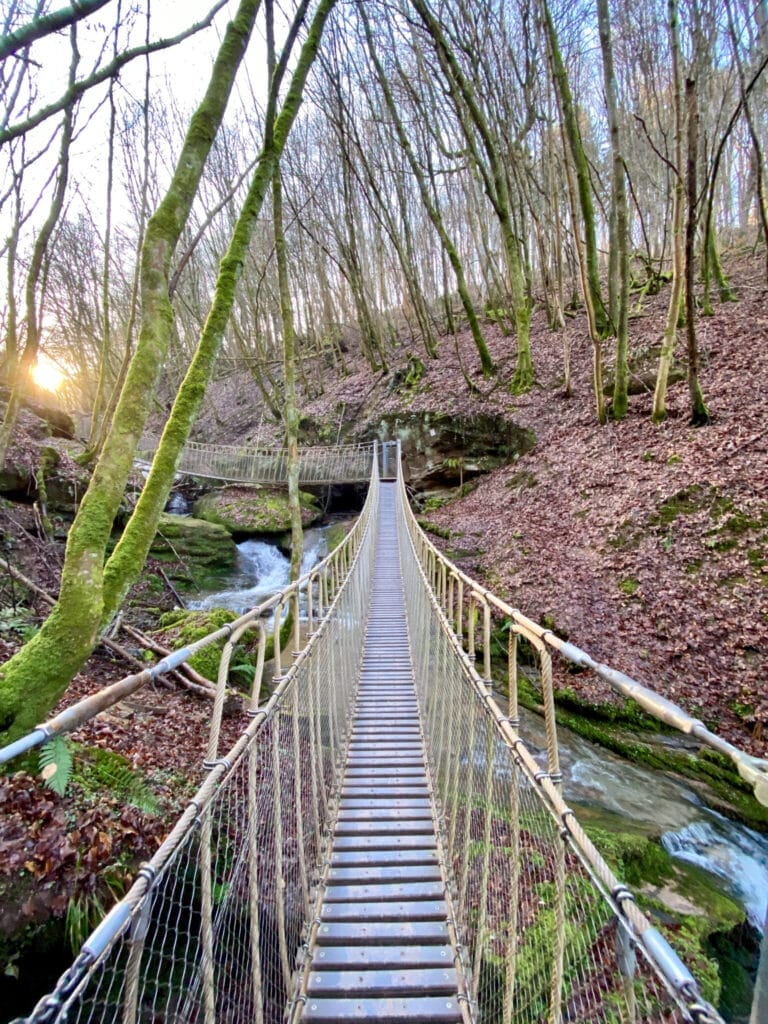
3. Hike the Roman Path in Kordel
Kordel is a little village located on the outskirts of Trier and is home to some pretty cool hiking trails! The Roman Path (Römerweg) takes you by the ruins of a small castle (Ramstein Burg), swinging rope bridges, spacious caves, the Geierlay lookout, and ancient Roman mines.
If you’re as into hiking as I am, this is up there as some of the best hiking in the Mosel Valley!
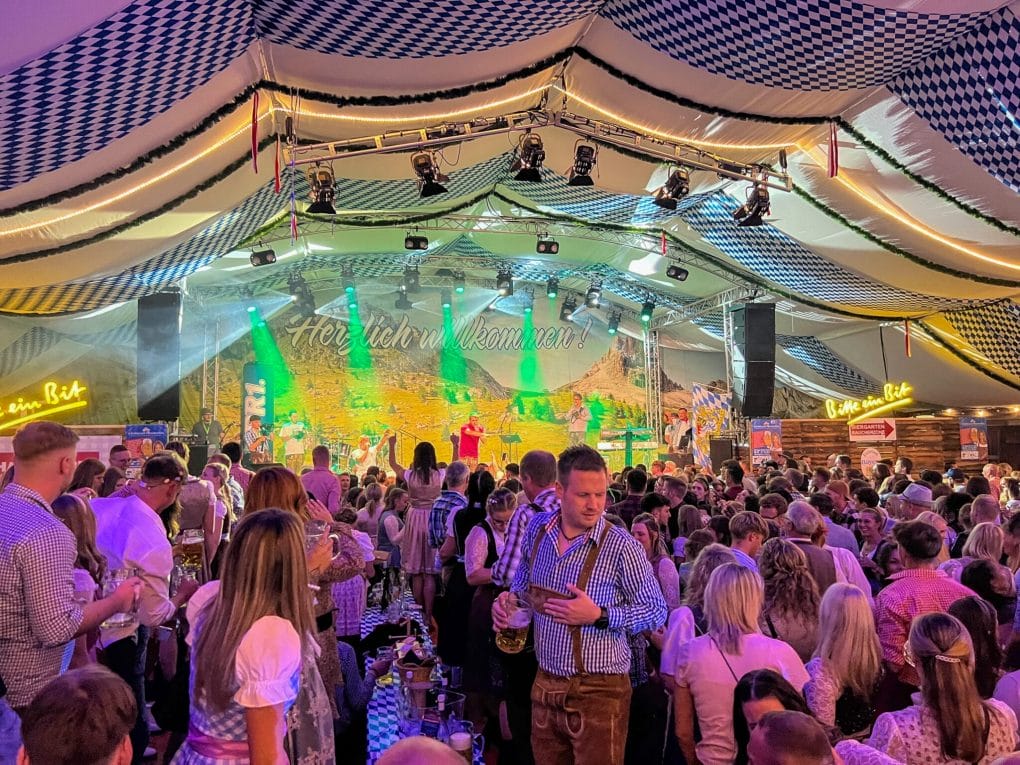
4. Party in lederhosen at the Koblenz Oktoberfest
Every year in late September and October, Koblenz hosts a large Oktoberfest, corresponding with the big Oktoberfest in Munich. The festival in Koblenz features a large tent and a stage with live music, promising a good time.
Unlike in Munich, you need a ticket to enter the Koblenz Oktoberfest, but it’s not too pricey. Once there, you’ll need to purchase a €30 or €50 stamp card you can use to buy beer, wine, cocktails, and soft drinks.
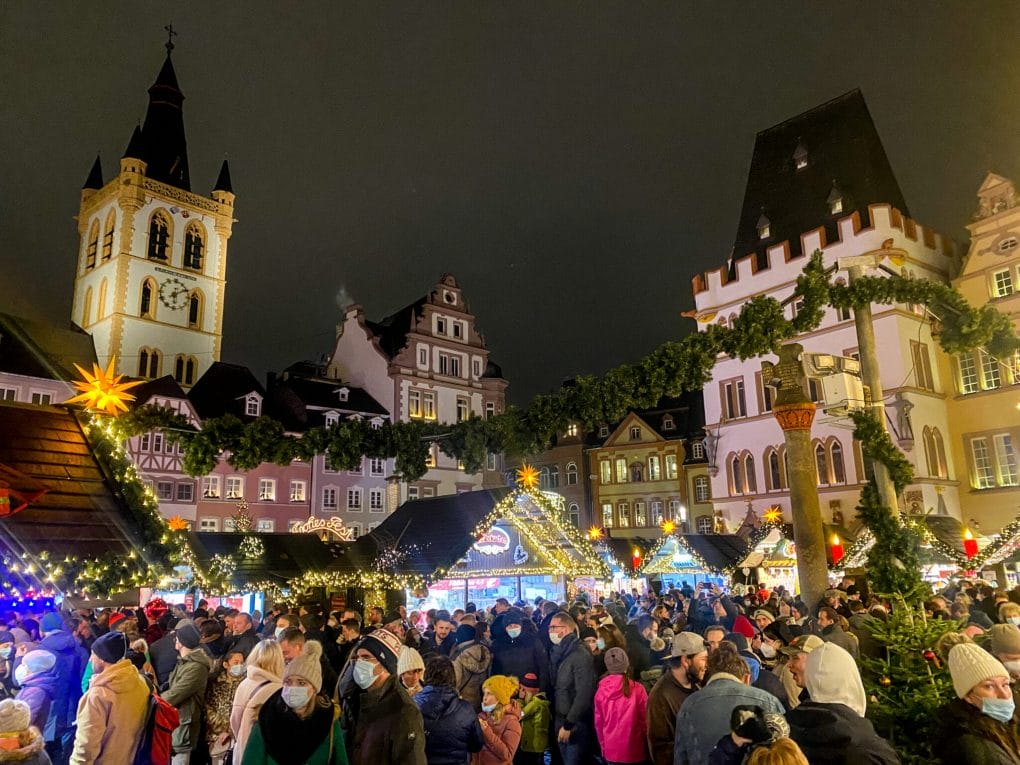
5. Experience unrivaled holiday cheer at a Mosel Valley Christmas market
There’s nothing quite like Christmas in Germany, and the magic is alive and well in the Mosel Valley. And in the Mosel Valley, the Christmas markets feature a particular emphasis on wine, paying homage to the region’s rolling vineyards.
Some of the best Christmas markets in the Mosel Valley can be found in:
- Trier: A nationwide favorite framed by medieval architecture and Germany’s oldest cathedral
- Bernkastel Kues: Home to the largest advent calendar in the region
- Traben Trarbach: A small market hosted in a historic wine cellar
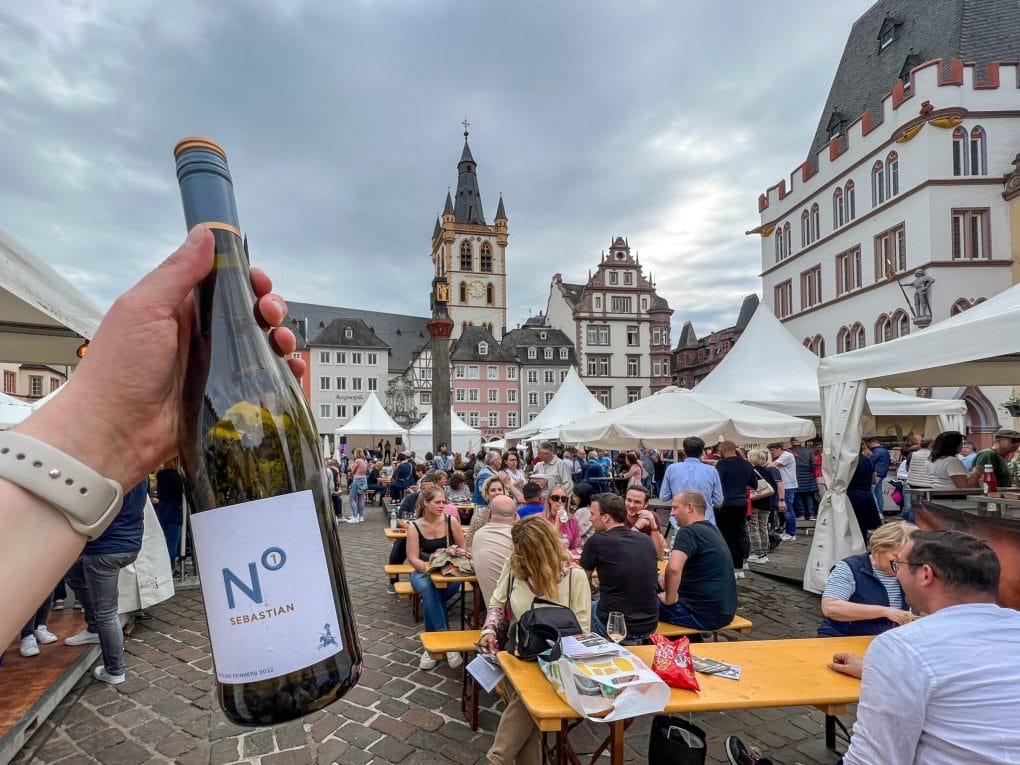
6. Go to one of the region’s many wine festivals
If there’s one thing Germans love (besides beer and wine), it’s a good festival. So, of course, wine festivals are a no-brainer, and there’s no shortage of them in the Mosel River Valley.
The dates change every year, but most wine festivals are held before summer turns to fall, at the end of August and the beginning of September.
Most towns and cities in the region host a wine festival, some bigger than others. The most notable events include Bernkastel, Traben-Trarbach, Trier, and Cochem.
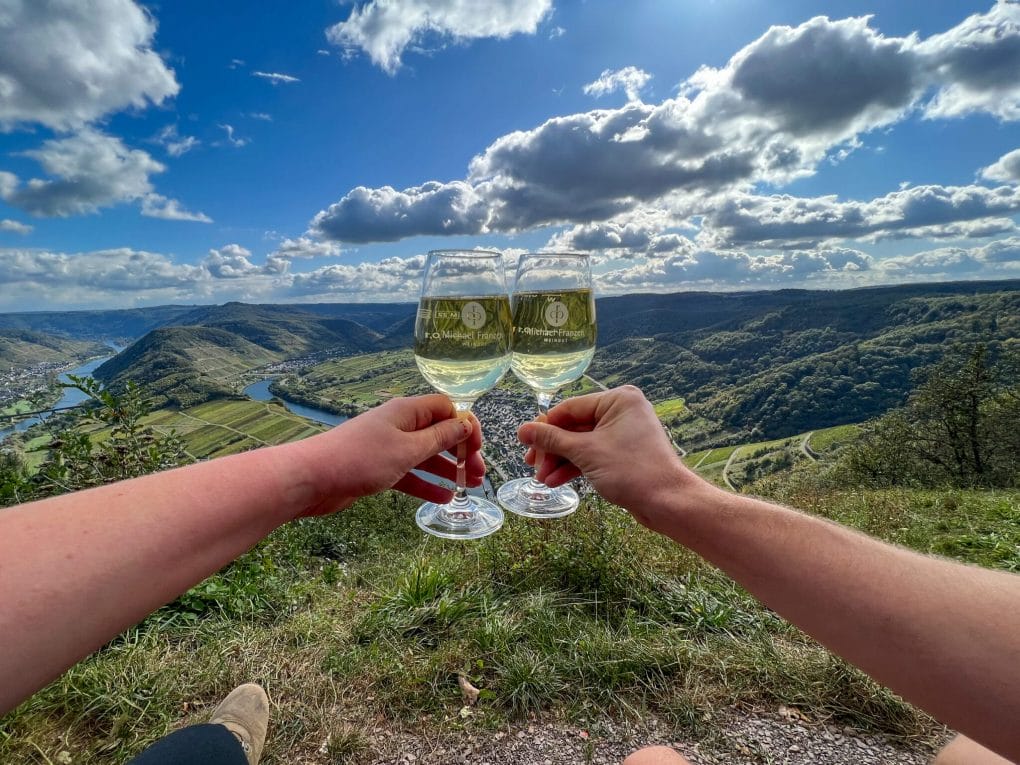
7. Hike the Moselsteig Trail and sip wine along the way
The Moselsteig Trail is a long stretch of trail that follows the Mosel River for 227 miles (365 km). The Moselsteig is broken up into 24 segments, making tackling the scenic trail one piece at a time easy.
You can learn more about the Moselsteig Trail on their official website where they break down the stats, maps, and what to expect for each segment.
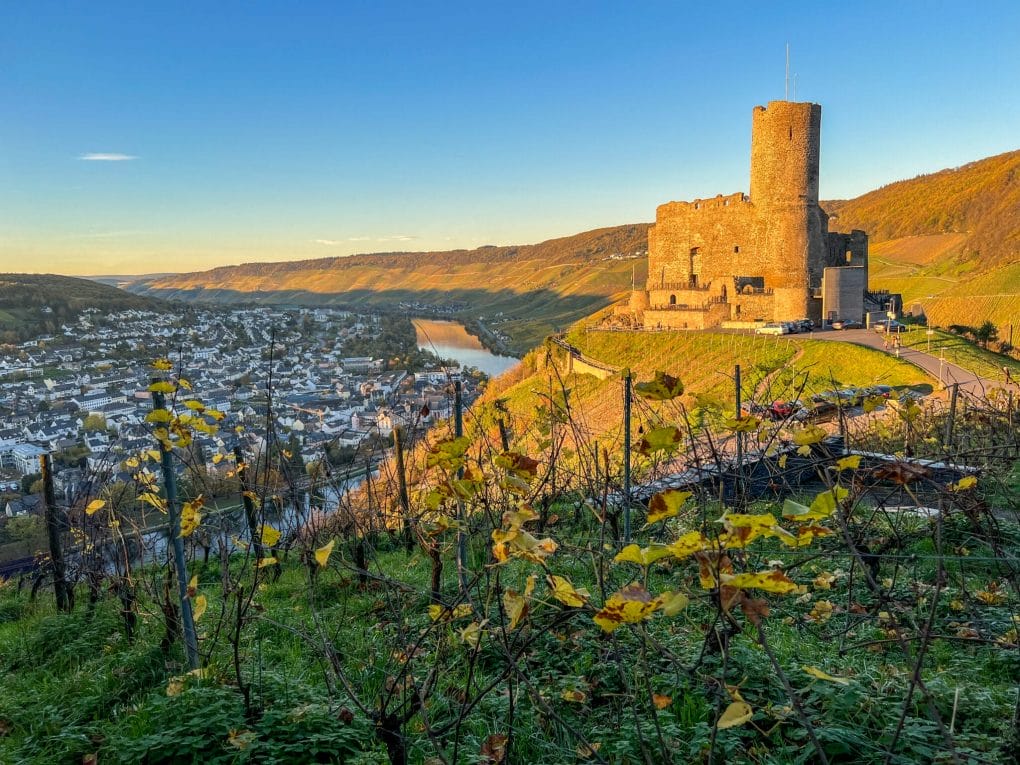
8. See more Mosel River castles
As if the rolling hills and lush vineyards against the background of the river aren’t scenic enough, there are more than a dozen castles that cement the Mosel River as a fairytale destination.
Burg Eltz and Reichsburg Cochem are two of the best-known and fully intact castles you can visit. But don’t sleep on those that are in ruins.
Here are some of the best castles in the Mosel Valley:
- Burg Eltz: A fairy-tale castle in the hills known for its well-preserved medieval architecture.
- Reichsburg Cochem: Overlooking the town of Cochem, this castle offers panoramic views of the Mosel Valley.
- Burg Thurant: Situated near Alken, it’s an impressive castle with a commanding presence along the river.
- Burg Landshut: Located in Bernkastel-Kues, it combines medieval charm with stunning vineyard views.
- Burg Thurant: Positioned near Alken, it boasts a commanding position along the river.
- Burg Metternich: Overlooking Beilstein, the castle provides a captivating view of the Mosel River.
9. Race in a life-sized video game at Battle Karts Trier
BattleKart Trier is a real-life video game experience where you can drive go-karts on a projected track or game board. They offer a variety of games including a classic race where you can collect power-ups and sabotage your competitors and friends.
The track is in the suburb of Kenn a 15-minute drive from the city center. You must reserve a spot in advance, and sessions are booked in 15-minute increments. We usually book 2-3 sessions for a total of 30-45 minutes of play. There’s a small bar at the track too!
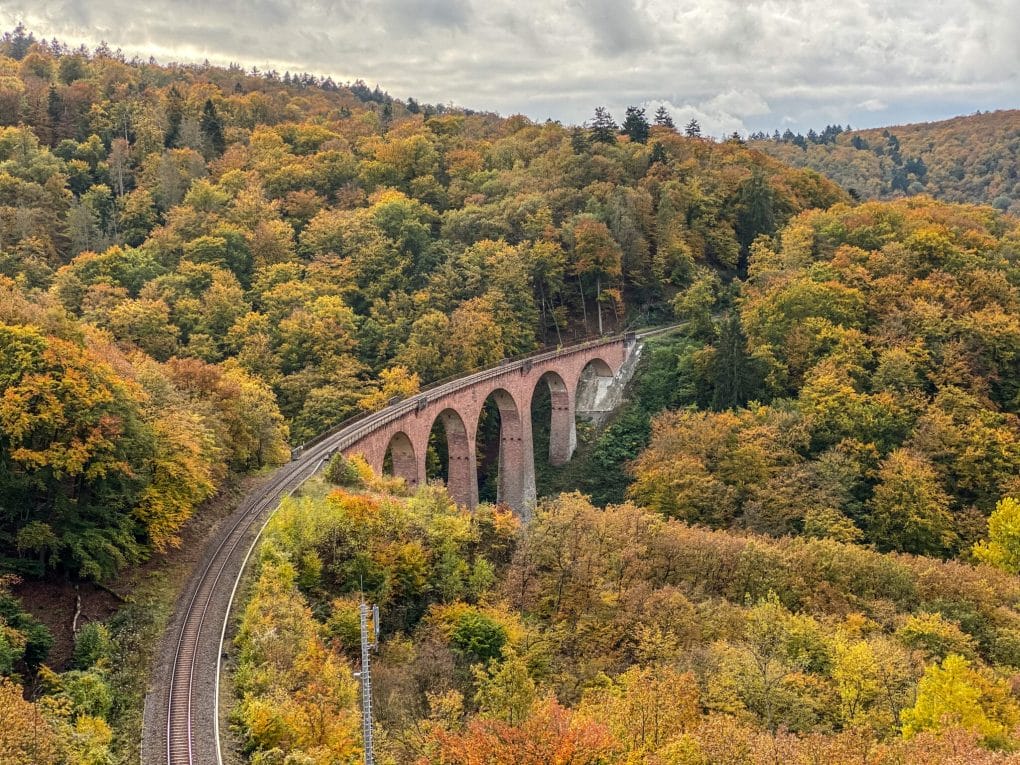
10. Witness fall colors at Hubertus Viadukt in Boppard
The Hubertus Viadukt hiking trail is one of the best places to witness fall colors near the Mosel Valley. The trail takes you to lookouts, where you can see the colorful leaves that create a lovely background against the historic Hubertus Viadukt (arched bridge) brick. If you time it well, you’ll even be able to see the train pass over the bridge.
From there, the trail takes you down and under the viaduct for up-close viewing. There are a few different loop options, but the popular one is just under 4 miles (6.15km). Peak fall foliage depends on the season but usually hits the end of October.
Boppard and the hike are along the Rhine River, but only a 20-minute drive from where the Mosel and Rhine meet in Koblenz.

11. Learn more about one of Germany’s most popular beers at the Bitburger Brewery
Bitburger is one of Germany’s most popular beers and number one in the Mosel Valley. So what better way to experience the area than with a Bitburger Brewery Tour?
The brewery is about 30 minutes from Trier/the Mosel River in the mid-sized town of Bitburg. The tour is unfortunately not offered in English, but it was still cool nonetheless, especially with the included tasting and excellent gift shop.
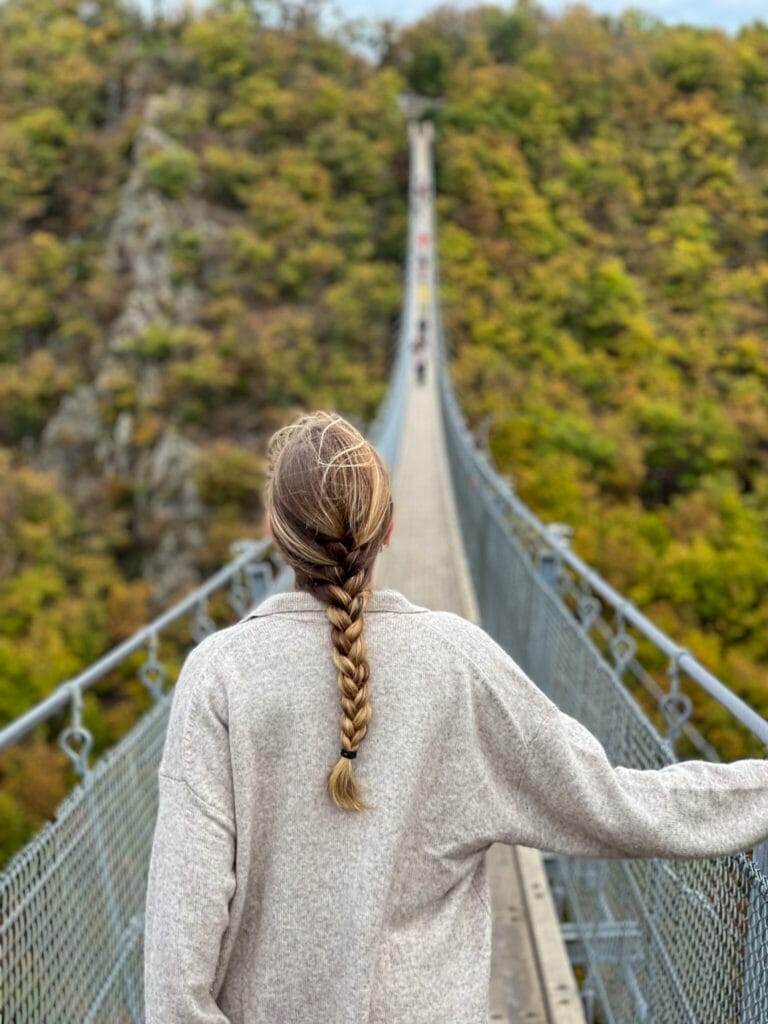
12. Cross the longest suspension bridge at Geierlay
The Geierlay suspension bridge is an epic bridge in Hunsrück, 20 minutes from the Mosel River town of Beilstein.
Although not technically in the Mosel Valley, it’s close enough and worth the small detour. This epic bridge is 1181 feet long (360 meters) long and 328 feet high (100 meters), making for an adventure-filled day trip.
The bridge is free to cross, and there are hiking loops you can do after crossing the bridge. The area is also a great place to visit to see fall foliage.
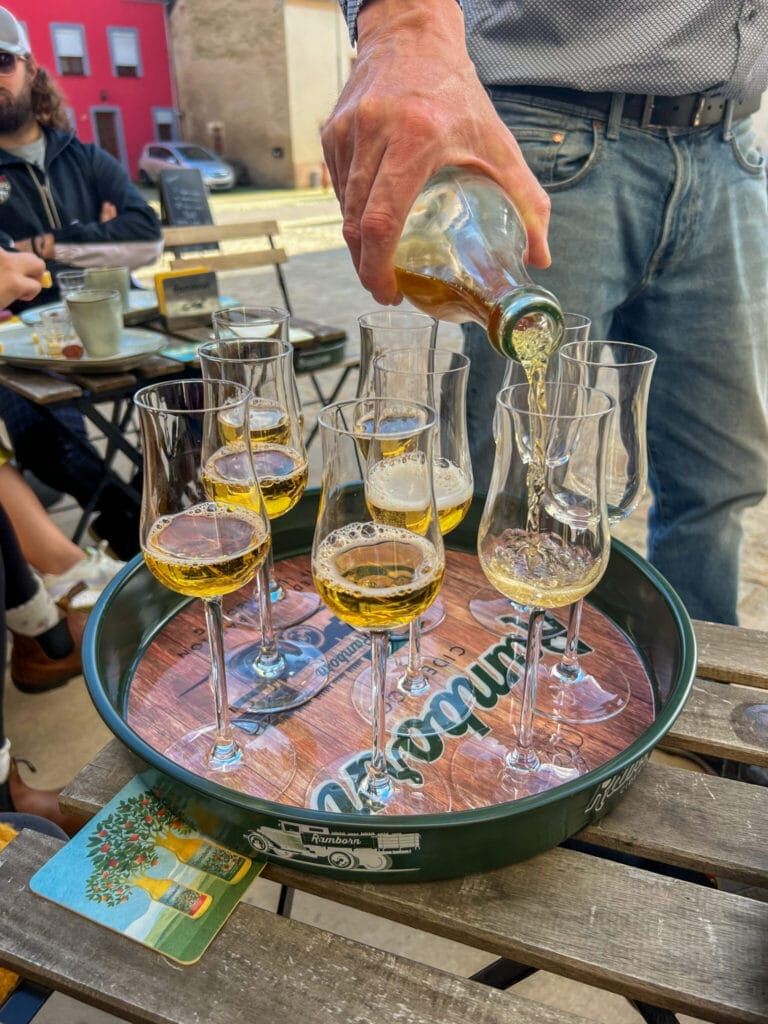
13. Sample locally grown and produced cider at Ramborn Cider Co
The Mosel River Valley may be best known for wine, but the Ramborn Cider Co. is a fun thing for cider lovers to do. This locally owned business is the first cidery in Luxembourg and only uses freshly pressed apples and pears from the region in its delicious beverages.
We did the 90-minute tour and saw some of the orchard’s pear and apple trees, the cellar, where the produce gets processed, and enjoyed a comprehensive tasting afterward. I really enjoyed the tour and even left with some bottles to enjoy later.
You’ll find this hidden gem across the German border in Luxembourg, less than 10 minutes from the Mosel town of Wasserbillig.
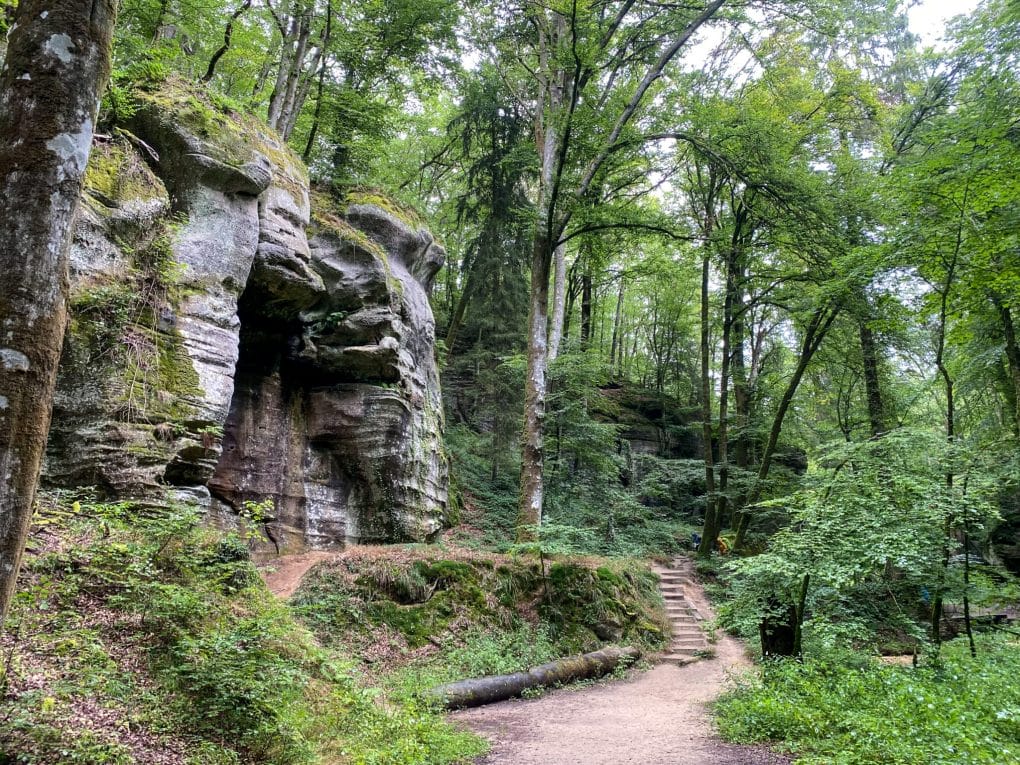
14. Explore more of the Luxembourg side of the Mosel River
The Mosel River Valley extends from Germany into Luxembourg and France, which means more places to explore and enjoy!
In Luxembourg, the valley is actually the Moselle River Valley and comprises the cute towns of Remich, Grevenmacher, and Wasserbillig. Here, you can soak up the small-town charm and sip locally-grown wines.
The popular Mullerthal Trail is not far away, an exciting trail that takes you through caves, past unique rock formations, and lush forests. The trail is quite long, but the closest segment to the Mosel Valley is Route 2, beginning in Echternach.
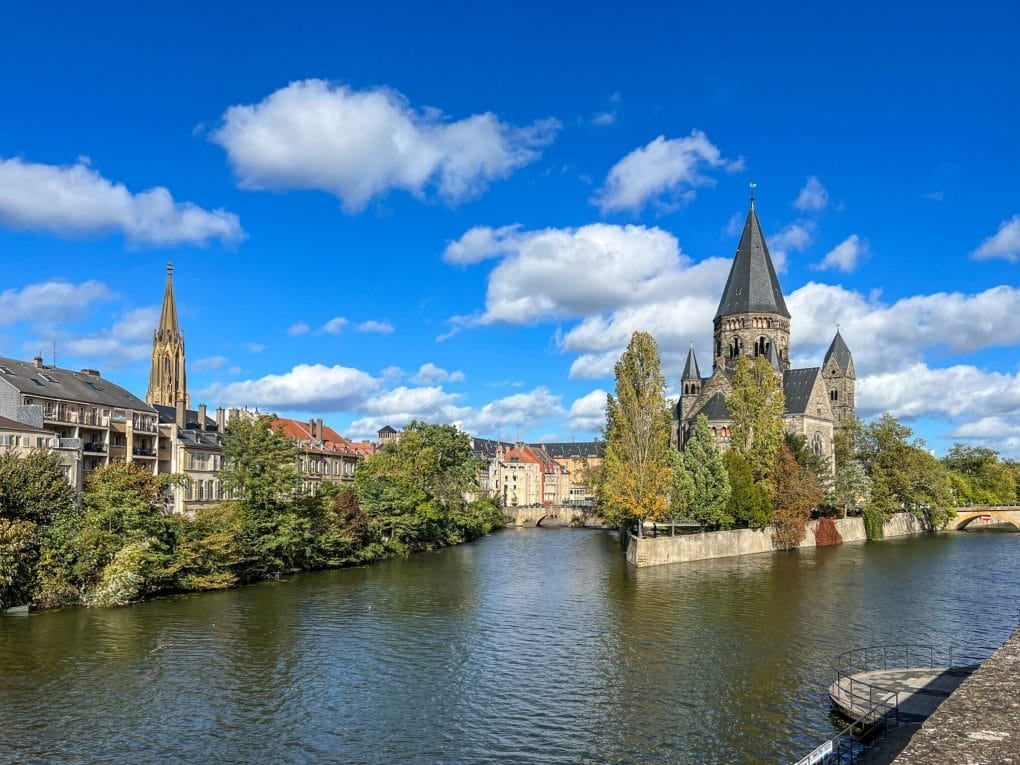
15. Explore the French side of the Moselle Valley
The French part of the Moselle Valley is located in the northeastern part of the country, near the border with Germany and Luxembourg. The French Moselle is distinct for its cultural heritage and ties to German and French influences.
Metz is a notable city in the French Moselle region and is a perfect introduction to the French side. This charming town offers French wines, cuisine (unbeatable and better than German, TBH), and beautiful historical landmarks.

16. Take a mini detour to experience the treetop walk Baumwipfelpfad Saarschleife
The Baumwipfelpfad Saarschleife is a remarkable boardwalk structure spiraling upwards, providing a great vantage point of a pretty bend in the Saar River.
The Saar River is actually a branch of the Mosel River, located about 30 minutes from Konz, making this the furthest recommendation from the Mosel Valley. However, if you have a car, the time, and an appreciation for pretty nature and a unique landmark, this place is for you!
After you finish the boardwalk, you can hike some short trails around it.

